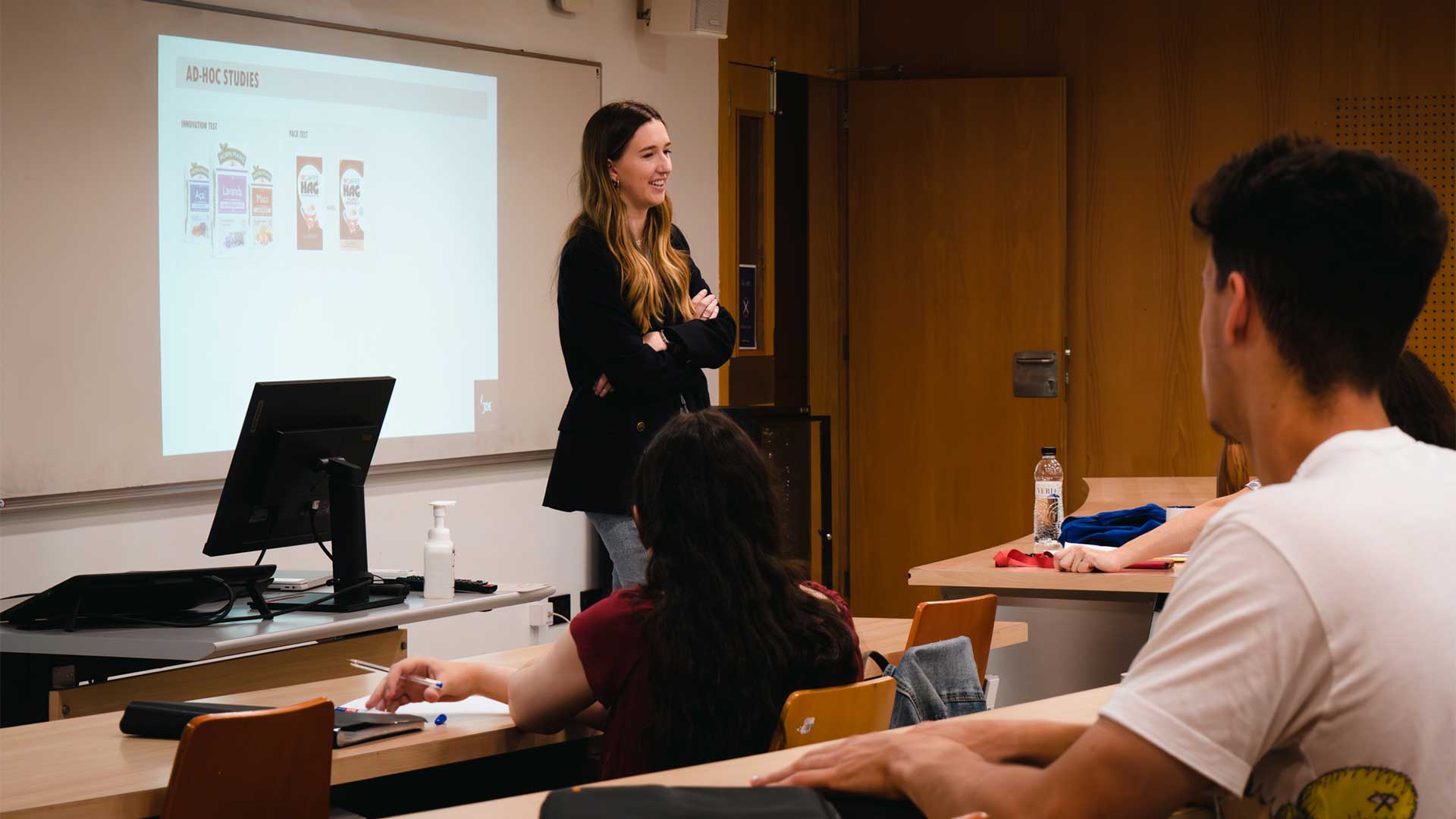Un nuevo comienzo
03/10/2024
El pasado 18 de septiembre se celebró la graduación de los alumnos del Máster en Gestión Internacional y del Máster en Marketing Digital Internacional en la sala de actos de ESCI-UPF.

Last week, Blanca Fabian, ESCI-UPF alumni, came to our Statistics class to talk about how she applies statistics in her career and how it is helpful in the business field, using data-driven evidence to support the company’s strategic marketing decisions and making use of the inferential statistics we have been learning in class.
Blanca Fabian finished her Degree in International Business and Marketing in 2018, specializing in Market Research since she enjoyed working with numbers. Her path after ESCI-UPF was most successful and rather unusual: she worked as an intern at KANTAR –a data agency that provides insights to clients worldwide– for two years. When the company finally decided to hire her, Jacobs Douwe Egberts (JDE) –a global coffee and tea company– made her a job offer she couldn’t reject.
She worked there for nearly two years as a consumer research specialist, and in 2020 she was promoted to a manager position in the same field for Southern Europe. Despite the challenges of being a manager at such young age and with limited working experience, she has risen to the challenge, and now she is managing a whole team.
Customer insights consist in deeply understanding the needs, wants, preferences and behaviour of consumers or potential customers through research and provide companies with valuable information about their target audience.
The first crucial question consumer insights ask is, “Who is our consumer”. It goes from age and gender to more in-depth questions like what brands consumers purchase, why they choose one brand over another, what the customer will need from the brand in the future, and much more.
Then, it is essential to know how and why to track data, not only superficially analyzing the sales data but also understanding the drivers of the growth of a brand. Some sources of data can be Nielsen or Kantar, as Blanca explained.
Statistics become more relevant in ad-hoc studies (both qualitative and quantitative) done through a series of techniques. Innovation tests, for example, are crucial to determine if a product will be successful in the future. It was eye-opening when Blanca explained that 90% of ideas would not make it in the future, which is why running this type of test is important, despite their high costs. A product will not be launched if it has less than a 60% success rate.
Usage and appliance studies are good for measuring new systems’ success, finding new market trends and whether they can be applied in the business. She also mentioned pack tests (to evaluate packaging), link tests (to see if a spot in television will be significant), blind tests and focus groups, for instance.
Before carrying out a quantitative test, three crucial steps should be followed:
First, a business objective must be set to understand what question the firm needs to answer, like “What does the consumer need from me.”
Then, the type of test that will be carried out must be established and choose the better methodology to apply.
Finally, the target needs to be specified, finding out what consumers the firm needs to understand better –narrowing their age, gender, region, brands, sample size, etc.
Many data agencies provide the most suitable subjects to create representative samples, depending on the needs of the business.
Blanca also helped us understand this type of research by providing some examples of the above explained. One of the cases was an innovation test to prove that a new Marcilla coffee blend could be successful in the market. The results were positive, given that 70% of the data ensured the customer would buy the product. Therefore, the product was launched and was extremely best-selling, clearly showing the usefulness of running these tests.
Blanca’s research was also useful to justify that if a customer had a L’Or Barista machine at home, they would be more willing to purchase L’Or coffee capsules –even if the production cost of the devices was so high they wouldn’t receive any profits. A panel test demonstrated that Blanca’s hypothesis was correct; thus, the inversion was justified.
The Blanca Fabian masterclass was enriching and gave us a new perspective on statistics and market research that at least I had never considered before.
03/10/2024
El pasado 18 de septiembre se celebró la graduación de los alumnos del Máster en Gestión Internacional y del Máster en Marketing Digital Internacional en la sala de actos de ESCI-UPF.
26/09/2024
Càritas Diocesana de Barcelona premia els Treballs de Fi de Grau que destaquen pel seu contingut social. La setmana passada es van donar a conèixer els guanyadors del GNMI dels cursos 2021-2022, 2022-2023 i 2023-2024: Alexia Piqué, Martí Parera i Anna Medallo.
24/07/2024
El passat 4 de juliol, ESCI-UPF va acollir l’acte acadèmic de graduació de la sisena promoció del Grau en Bioinformàtica.
Leave a message